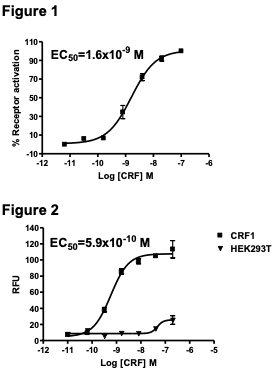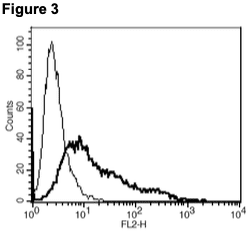Product Information
Catalog Number:
C1040
Lot Number:
C1040-072611
Quantity:
1 vial (2 x 106) frozen cells
Freeze Medium:
Sigma Freezing Medium (C-6164)
Host cell:
HEK293T
Transfection:
Expression vector containing full-length human CRHR1 cDNA (GenBank Accession Number NM_004382.3) with FLAG tag sequence at N-terminus
Recommended Storage:
Liquid nitrogen upon receiving
Propagation Medium: DMEM, 10% FBS, 1 μg/mL puromycin
Stability:
Stable in culture for minimum of two months
Data Sheet
Background: Hypothalamic corticotropin releasing hormone (CRH) exerts its diverse physiological actions via cell surface G protein-coupled CRH receptors (CRHRs), of which two subtypes (CRHR1 and CRHR2) have been identified. CRH regulates pituitary ACTH secretion and mediates behavioral and autonomic responses to stress. Overproduction of CRH and stress system abnormalities are associated with psychiatric diseases such as depression, anxiety, eating disorders, and addiction. CRHR1 is expressed in pituitary corticotrophs and the brain. CRH binds to CRHR1 with high affinity, and activation of CRHR1 by CRH increases cAMP intracellular levels and activates protein kinase A. CRHR1 also couples to activation of MAPK as well as protein kinase C in an isoenzyme-specific manner. Selective CRHR1 antagonists offer new possibilities for the treatment of anxiety and depression.
Application: Functional assays


Figure 1. Dose-dependent stimulation of intracellular cAMP level upon treatment with ligand, measured with MultiscreenTM TR-FRET cAMP 1.0 No Wash Assay Kit (Multispan MSCM01). Figure 2. Dose-dependent stimulation of calcium flux upon treatment with ligand, measured with MultiscreenTM Calcium 1.0 No Wash Assay Kit (Multispan MSCA01). Figure 3. Receptor expression on cell surface measured by flow cytometry (FACS) using an anti-FLAG antibody. Thin line: parental cells; thick line: receptor-expressing cells.
References:
Dermitzaki et al. (2005) Corticotropin-releasing hormone activates protein kinase C in an isoenzyme-specific manner. Biochem Biophys Res Commun 327:828-836.
Muller and Wurst (2004) Getting closer to affective disorders: the role of CRH receptor systems. Trends Mol Med 10:409-415.
Refojo et al. (2005) Corticotropin-releasing hormone activates ERK1/2 MAPK in specific brain areas. Proc Natl Acad Sci U S A 102:6183-6188.
